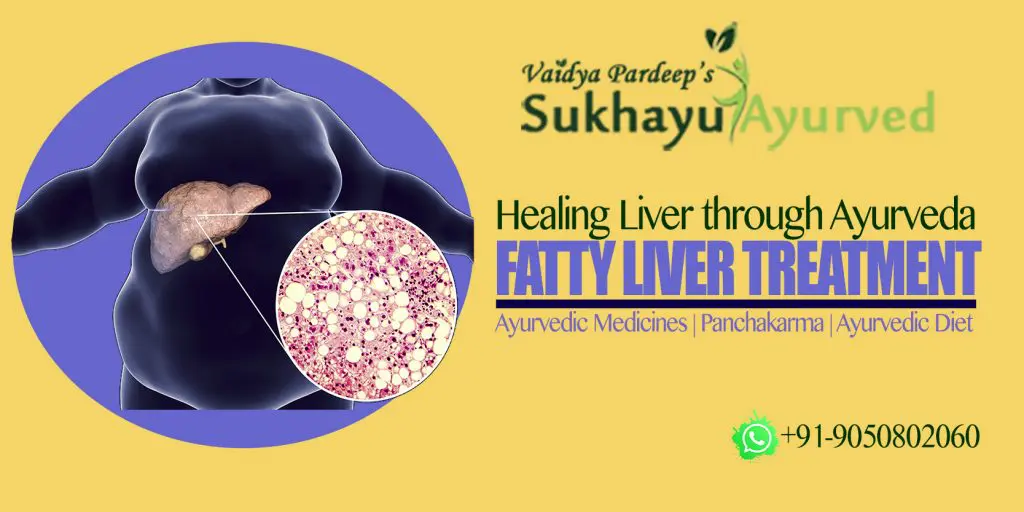When you are suffering from fatty liver, you are among 32% of people. Yes, out of 100, 32 people are suffering from fatty liver. Yes, this is common. But when it comes to treatment, we have only one hope and that hope comes from Ayurveda. In western medicines, there are hundreds of medicines that endanger the liver, but when it comes to reviving the liver, options are near zero. So we need to know all aspects of Ayurvedic Treatment for Fatty Liver, the approach Ayurveda takes, and also the timeline for healing back your liver back to normal.

Ayurvedic Treatment for Fatty Liver is important in time because once overlooked this can lead to other problems with the liver.
Fatty liver happens due to the building of fat in the liver. It is also termed hepatic steatosis.
Suffering from fatty liver disease means that your liver has extra fat.
It is normal to have small amounts of fat in the liver. However, too much fat causes liver inflammation that damages the liver and results in scaring. In severe cases, scaring leads to liver failure.
Types of Fatty Liver
Fatty liver is of two types:
- Non-alcoholic Fatty Liver Disease– It is a type of fatty liver disease not related to heavy alcohol intake.
- Alcoholic Fatty Liver Disease – It develops due to too much alcohol abuse.
Let us discuss about non-alcoholic fatty liver disease in detail.
Non-alcoholic Fatty Liver Disease
As discussed above, non-alcoholic fatty liver disease or NAFLD develops in people who drink no or very little alcohol. The main characteristic of this disease is too much fat in the liver cells. It is of two types:
- Simple fatty liver – Simple fatty liver means that there is fat in your liver, but there is no sign of inflammation or damage. In most cases, the simple fatty liver does not cause any problem with your liver and does not get worse. Most of the people suffering from non-alcoholic fatty liver disease have simple fatty liver.
- Non-alcoholic steatohepatitis – Non-alcoholic steatohepatitis is a severe condition. There is inflammation in the liver. The liver cell begins to damage resulting in cirrhosis and fibrosis. This condition may also progress to liver cancer. About 20% of people suffering from non-alcoholic fatty liver disease develop non-alcoholic steatohepatitis.
Facts about Non-alcoholic Fatty Liver Disease
- If the fat build up in the liver is more than 5%, then it is a fatty liver.
- It is more common in those who consume more sugars and fats than their body can handle.
- It is common in obese and overweight but can also happen in adults with healthy body weight.
- Non-alcoholic fatty liver does not always mean any immediate harm, but it is a concern as the extra fat may cause inflammation and further injury leads to scarring in the liver
- Many people have fatty liver but may not display any symptoms.
- A healthy diet low in sugar and trans-fats can prevent as well as reverse this condition.
- Even patients suffering from non-alcoholic fatty liver disease need to avoid alcohol or consume a very small amount to prevent further damage.
- Fatty liver may be related to high blood pressure, diabetes, high cholesterol, and obesity. It may also occur during pregnancy.
Symptoms of Non-alcoholic Fatty Liver Disease
People with simple fatty liver usually do not experience any symptoms. About 75 percent of patients with non-alcoholic steatohepatitis have liver swelling and experience the following signs and symptoms:
- Fatigue and tiredness
- Lack of energy
- Muscle weakness
- Low appetite
- Nausea
- Weight loss
- Swelling in the upper abdomen
- Discomfort in the upper abdomen.
As the above symptoms also resemble the signs of several other health issues, tests are required to eliminate other conditions.
About 10 to 25 percent of people suffering from non-alcohol steatohepatitis develop fibrosis, cirrhosis, or liver failure.
The symptoms are:
- Nausea and vomiting
- Diarrhoea
- Tiredness and weakness
- Tarry stools
- Swollen abdomen
- Pain in the abdomen
- Yellow eyes and skin
- Difficulty focusing, memory loss, confusion and hallucinations
- Itchy skin
- Bleeding easily
Severe cases may also require a liver transplant.
Cause of Non-alcoholic Fatty Liver Disease
What causes non-alcoholic fatty liver diseases is not apparent. It develops when the body produces too much fat or liver is unable to process fat properly.
Risk factors for non-alcoholic fatty liver include:
- Obesity – Around 70 percent obese people suffer from this condition. However, about 10 to 15% of people with normal weight may also suffer from fatty liver.
- Excess belly fat – A person with deep abdominal fat is more at the risk of developing fatty liver.
- Consumption of sugary beverages– Sugar-sweetened beverages such as energy drinks and soda are very high in fructose and increases the risk of accumulation of fat in the liver in both children and adults.
- Impaired Gut health – Studies show having impaired gut health and imbalance in the gut bacteria or other gut issues such as leaky gut contribute to non-alcoholic fatty liver disease.
- Insulin resistance – High insulin level and insulin resistance, increase liver fat storage in individuals with metabolic syndrome and diabetes.
- High intake of refined carbs – High consumption of refined carbs promotes the storage of fat in the liver. This especially happens in obese and insulin resistant.
- Diabetes – About 40 to 80% of patients with type 2 diabetes suffer from non-alcoholic fatty liver disease.
- High blood triglyceride, high blood pressure and a high level of cholesterol in blood also increases the risk.
Other suggested factors that may increase the risk of NAFLD are:
- Smoking
- Heredity
- Old age
- Rapid weight loss
- Exposure to certain toxins
- Infections such as hepatitis
- Certain medications such as tamoxifen steroid for cancer treatment
How Fatty Liver Occurs
Liver is the second largest organ of our body. Its primary function is to process the nutrients from drink and food and filter the harmful substances from our blood. If it does not function properly, if fat is not metabolized properly or if the body produces, too much of fat, fat gets build up in the liver. Too much fat build-up in the liver causes fatty liver. Simple fatty liver diseases is not healthy, but fat build-up is not enough to produce any symptoms. If fat continues to accumulate, the liver gets inflamed, and the disease progresses to non-alcoholic steatohepatitis and eventually leads to cirrhosis and liver failure
Alcohol-related Fatty Liver Disease Alcohol-related fatty liver disease is not just preventable but also gets better when you stop taking alcohol.
If the individual keeps on drinking, the alcohol-related fatty liver disease progress to serious health issues such as:
- Enlarged liver – It may not cause symptoms, but the patient experiences discomfort and pain on the upper right side of their belly.
- Alcoholic Hepatitis – It is characterized by symptoms such as fever, nausea, belly pain vomiting.
- Alcoholic Cirrhosis – With time, alcoholic hepatitis turns into alcoholic cirrhosis. It has and symptoms the same as alcoholic hepatitis along with enlarged spleen, bleeding in the body, high blood pressure in the liver, large amounts of fluid build-up in the patient belly and liver failure that can be fatal.
Western medicine has little to offer to cure fatty liver. However, Ayurveda offers promising results to improve the function of the liver. Here are the details about the Ayurvedic Treatment for Fatty Liver.
Ayurveda about Fatty Liver
5000 years before the modern medicines, Charaka and Sushruta talk about the organ Yakrit. Yakrit is liver. Yakrit works as the seat of Agni and is responsible for healthy blood.
According to Ayurveda, Agni is the core concept of digestion and metabolism. Whatever we eat becomes usable for the body because of the Agni only. Therefore all the conditions and symptoms associated with fatty liver are similar to the condition of – Madagni and Ajeerna. Besides the concept of Agni, Ayurveda talks about the other condition of Yakritodara (Hepatomegaly).
When we look at the symptoms of the yakritodara, it becomes clear about the Ayurvedic understanding of the fatty liver according to Ayurveda.
- दौर्बल्य– Weakness
- अरोचक– Lack of appetite
- अविपाक– Indigestion
- वर्चोमूत्रग्रह– Constipation
- तमःप्रवेश– Black outs
- पिपासा– Excessive thirst
- अङ्गमर्द– Body malaise
- च्छर्दि– Vomiting
- मूर्च्छा– problem with concentration
- अङ्गसाद– Stiffness in the body.
- कासश्वासमृदुज्वर – Coughing, problem with breathing, low grade fever.
- आनाहा – Flatulence
- अग्निनाश- Loss of digestive power
- कार्श्या– loss of strength in the body.
- आस्यवैरस्य – Bad taste in mouth
- पर्वभेद– Joint pain
- कोष्ठवातशूलानि – Tenderness in the abdomen due to flatulence.
If we compare the list of signs and symptoms of fatty liver with the conventional system of medicines. These are very much the same.
Ayurveda treatment of the fatty liver is planned according to the guidelines of the text.
Ayurvedic Treatment for Fatty Liver
The main concern of the Ayurvedic Treatment for Fatty Liver is to restore the normal structure and working of the liver. The structure and working of the liver are connected to each other and complement each other.
There are two options of the Ayurvedic Treatment for Fatty Liver-
- Treatment of fatty liver with ayurvedic medicines.
- Treatment of fatty liver with Panchakarma.
Which line of Ayurvedic Treatment for Fatty Liver will help a patient is all dependent on the severity and chronicity of the condition. The strength of the patient is also counted for this.
The following patients get benefit through Ayurvedic medicines only-
- Fresh case of fatty liver (not older than 1 year).
- Patient without any history of alcohol.
- Where patient doesn’t have complete manifestation of all the symptoms.
The rest of the patients, who have chronic problems with the fatty liver, might need Panchakarma treatment too. But overall only 1-2% of patients need panchakarma for the condition of fatty liver.
What do you need for treatment of fatty liver through Ayurveda
The first step like many other treatments is – Primary assessment with Vaidya Pardeep or Vaidya Neetu. You need to come to Jaipur. This you need to do after making an appointment. You can check the details about – “Consultation preparation”.
After the primary assessment, we prescribe medicines, share the details about the diet and lifestyle. According to that, you need to follow the treatment.
Panchakarma is hardly done in case of fatty liver disease, so you don’t need to stay or admit to the hospital.
Now you might have one last query and that is important to address-
Why does modern medicines think Fatty liver as incurable?
Fatty liver is manageable in modern medicines but not treatable or curable. But in Ayurveda, things are opposite. Fatty liver is completely curable through Ayurveda treatment.
The main reason for the failure of modern medicines is – most of the modern medicines are hepatotoxic. Means these ruin liver. And this is the main reason why modern medicines don’t have an option of Ayurvedic Treatment for Fatty Liverent of fatty liver.
The simple-chained medicines of Ayurveda don’t need the involvement of the liver in the assimilation of the medicines. This makes Ayurveda the best choice for the treatment of many conditions.
How can you start Ayurvedic Treatment for Fatty Liver
The best way to start the Ayurvedic Treatment for Fatty Liver is one on one personal consultation. This helps us to get a proper idea about the condition of the patient so that treatment can be planned properly.
If you are away and cannot travel to Jaipur, we provide Video Consultation with our Vaidyas too.
To start the treatment, personal assessment and details are important. For this, you need to book an appointment with our Vaidyas. After booking an appointment we will share what details we need from your side.
So just follow, what you can do easily!!
And make sure that your liver will be healthy again!!













